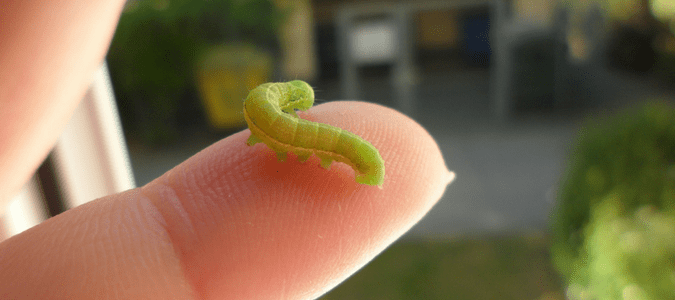
Have you heard of cankerworms? If you haven’t, you’ve undoubtedly seen them, especially in the spring, swinging from tree to tree as they defoliate large groups of trees at a time. What are cankerworms exactly? What does it mean for you as a homeowner? And how can you protect yourself and your trees against these creatures if they are causing a problem?
Cankerworms: What Are They?
Cankerworms, or “inchworms,” are spring caterpillars that are light green to brown. They’re different from ordinary caterpillars in that they have fewer legs than most, with only two feet on their abdomens, resulting in odd movement.
Cankerworms hatch just when the trees are starting to bud in the spring. They feed on broad-leaf trees like elm, oak, boxelder, maple, and ash. They can defoliate a large swath of trees, but you’ll only notice it if the trees they’re attacking are stressed by drought or disease.
Another type of cankerworm hatches in the fall so that the same trees can be hit twice a year.
The good news is, unlike other caterpillars, cankerworms have a seven-year cycle, which means that they are abundant for several years (four years on average), then are scarce for up to 18 years, which is why you might not have seen many of this type of caterpillar recently.
Cankerworms In Your Yard
As we’ve already pointed out, cankerworms can strip large swaths of trees of their leaves with little effort, but solid and mature trees can withstand a season or two of complete defoliation. However, suppose those same trees are also stressed by disease, limb dieback, drought, or other factors. In that case, such defoliation can be dangerous to the overall health of the trees and make them more likely to suffer lasting damage.
Even if you’re not worried about the health of your trees, you will likely find the cankerworms a nuisance when they drop out of those trees onto your picnic table or the doors and windows of your home. Fortunately, this is a springtime phenomenon that lasts only a week, so there is not much you’d necessarily need to do when that happens.
Cankerworms are not poisonous to animals and will not harm your yard, bushes, and other greenery; their only target is your trees.
Controlling Cankerworms
Whether you’re annoyed by cankerworms falling from the trees, the resulting moths hanging on the outside of your house, or you’re worried about the damage they might cause, there are two basic ways of controlling cankerworms: tree banding and the use of chemicals.
Tree Banding
Tree banding is a non-chemical way of treating your trees against cankerworms. A sticky barrier is applied to the tree trunk. Female cankerworm moths are wingless and crawl up the trees to lay their eggs. As they reach the damp wall, they’re trapped and can’t reach where the eggs are laid, close to the upper limbs and leaves.
Tree banding works great in theory, but there are several drawbacks. First, homeowners may forget to clean and renew the sticky barrier when it becomes full of moths. Second, unbanded trees in the area produce young cankerworms blown into the banded trees. Lastly, the damp wall is expensive and messy and can permanently mark the trees.
Chemical Treatment
If you are serious about getting rid of cankerworms, the chemical is the best way to treat trees. It’s essential to apply your treatments when the caterpillars are relatively small, while damage to the trees is limited, and the leaves of the trees are fully formed. If the leaves are still growing, chemical coverage is limited, reducing the effectiveness of the chemicals. For the spring cankerworms, the best time to apply an insecticide would be just as the trees are starting to bud, in the fall, just as the weather starts turning cooler.
There are several chemical options, but first, you should try a bacterial insecticide, Bacillus thuringiensis, which goes by the trade name Dipel or Thuricide. This insecticide is safe for the environment and doesn’t harm pets, wildlife, other insects, or humans. As with most insecticides, it’s best to apply them professionally to ensure the safest, most complete treatment possible for your trees.
Lawn Pests are No Match for ABC
Cankerworms are only around for a short period and may not be the pest damaging your trees or other plants. You can trust ABC Home & Commercial Services professionals to identify and diagnose your outdoor pest problem and take the appropriate steps to keep your plants and grass healthy and beautiful.